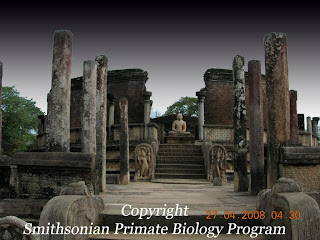 Polonnaruwa
Polonnaruwa in April starts to get warm and we are already experiencing the South West monsoon weather.

The monsoons bring two distinct periods of heavy rainfall to
Sri Lanka. From May to October the southwest monsoon brings moisture-laden air from the Indian Ocean. From December to March the northeast monsoon brings moisture-laden air from the Bay of Bengal.
These monsoon patterns combine with
Sri Lanka’s surface features to create two climatic zones in the country: a wet zone in the southwest and a dry zone in the north and east.

The wet zone is inundated with rain during both monsoon seasons, with some rainfall between the monsoons as well. The western slopes of the central highlands are the wettest area of the country, receiving average precipitation of more than 3,810 mm (150 in) each year.

In contrast, the dry zone usually receives rain only during the northeast monsoon. Periods of drought are common during the summer months. This zone has average annual precipitation of less than 1,905 mm (75 in). The driest parts of the zone along the northwestern and southeastern coasts receive about 1,270 mm (about 50 in) of rain each year.
There a sight warm breeze coming through.

This is a typical day at our camp.Normally we wake up by 6am to take our dog
Bossie for a walk.

It's a 7km walk from the camp on the
bund road.

There are two very small forest patches that we pass and on one, protruding on to the banks but still on the waters is a patch where a small macaque lives. We see her everyday when we pass. She'll be eating fruits or young leaves from the trees on her island habitat. We have not heard her give out any alarm calls or contact calls yet.
This island is about 100m from the bank and once the water level goes down and people start going to the
lakebed for whatever activities we suspects the poor animal will be forced to find another shelter away from dogs and other potential predators.

Nalaka,
Chameera's cousin who was about to drive out noticed a giant
squirrel pup fallen on the ground from it's nest. We heard it's mom's frantic alarm calls for over 20minutes till we managed to climb a tree and place it closer to
their nest. As we had to move away we never found out if the mother squirrel
succeeded carry her pup to the nest.

We are back by 7.30am and have breakfast before starting work. Breakfast is mostly traditional
Sri Lankan with string hopper with curry and pol
sambol or if there are visitors or researchers, will extend the variety to include toast and egg with tea or coffee.
The camp is at the peak of it's activities by 10am. The breakfast cleared away and cooks in the kitchen making rice and curry for lunch.
There are 5 of our Research staff who comes in to camp for their lunch and Data Summary work before going back to work at 4.00pm. the Senior Research Coordinator,
Sunil Gunathilke,
Chameera Pathirathne,
Ruwan Jayawardena,
Sunil Ratnayake and
Prasanna Jayampathie. Staff would follow and study the lives and diets of the dry zone Toque Macaque,
Macaca s
inica s
inica, the Purple Faced
Langur and the Gray
Langur. Out of which the Purple faced
langur is endemic to
Sri Lanka.

(Earthwatch volunteer, Stephanie Carter, from Canada)
By 7.30pm we all gather for dinner, with everyone contributing to the days excitement that passes.
The Field Research camp sits in an uncut forest patch of about 7acres. At any given time there are over 40 bird species including over 30 migrant species that come during the winter. Last October to March this year, we were fortunate to see the Racket Tailed
Drongo, Forest wag tail, Orange headed ground thrush and the Indian Pitta. One of the most common birds these days the sky larks and the
Sharmas with their loud territorial calls swinging on the branches with their tiny juveniles.
There is a resident mouse deer who our cook feeds scraps of bread and is semi scared of the rest of us. Several large water monitors and the injured and healing monkeys in the cage.
The latest is an infant toque macaque, one month old, whose mother was road kill. We assume it was born around 20
th March 2008.

He's fed infant formula ever two to three hours and everyone steps in to care for him. He's a strong little fellow with lots humans as his foster parents.
We have named him Seth, after the Egyptian God for (also spelled Seth,
Sutekh or
Seteh) is an ancient god, who was originally the god of the
desert, storms, and chaos. Due to developments in the
Egyptian language over the 3,000 years that Set was worshipped, by the Greek period, the t in Set was pronounced so indistinguishably from
th that the Greeks spelled it as Σεθ (Seth).




















 The mother of the dry zone, the Dry petes tree provides food and shade to all small mammals and other smaller plants during the hottest parts of the summer months.
The mother of the dry zone, the Dry petes tree provides food and shade to all small mammals and other smaller plants during the hottest parts of the summer months.














